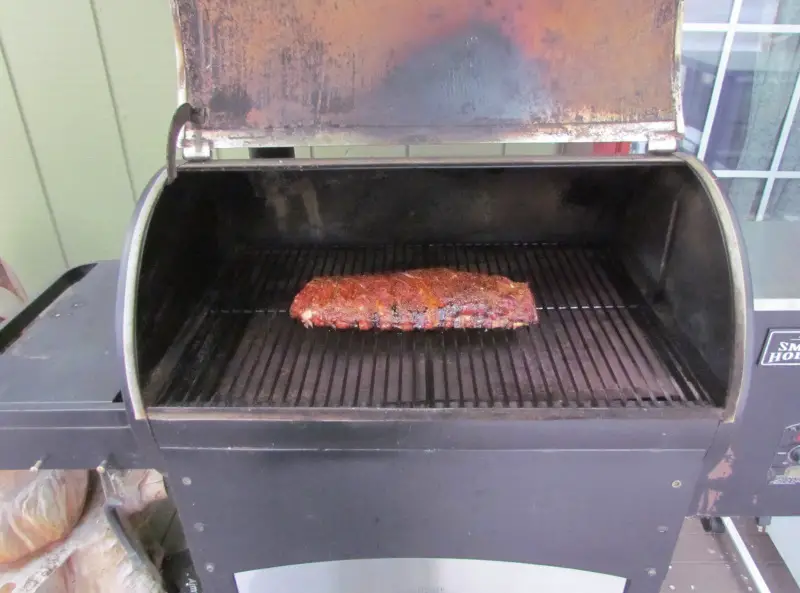
Smoking ribs in a pellet smoker is an incredibly popular way to get the best flavor results. It’s easy, but if you want to make sure those ribs turn out perfectly every time, then all it takes is the right prep and treatment methods followed by taking the right steps when smoking them.
Prep includes trimming off any excess fat and silver skin then coating your ribs with a dry rub that adds both flavor and tenderness when cooked. Then place your rack of ribs into the preheated pellet grill at a temperature of 225-250°F. Cook each side for two hours or until the internal temp reaches 170°F – be vigilant, as it’s important not to overcook.
Once finished, let them rest for about 10 minutes before serving so that your final product can retain its moisture. With these steps in mind, you can be sure of consistently excellent results when smoking pork or beef ribs in a pellet smoker!
The following is a detailed guide to show you how to prepare, treat, and smoke ribs effectively every time in your pellet smoker.
Note: most links in this article are Amazon.com Affiliate links, see Affiliate Disclosure, thank you.
What you will need to get started
Before getting started with smoking your ribs on a pellet smoker, it’s important to make sure you have all the essential items. The worst thing that can happen is getting halfway through the process and realizing you are missing a crucial item.
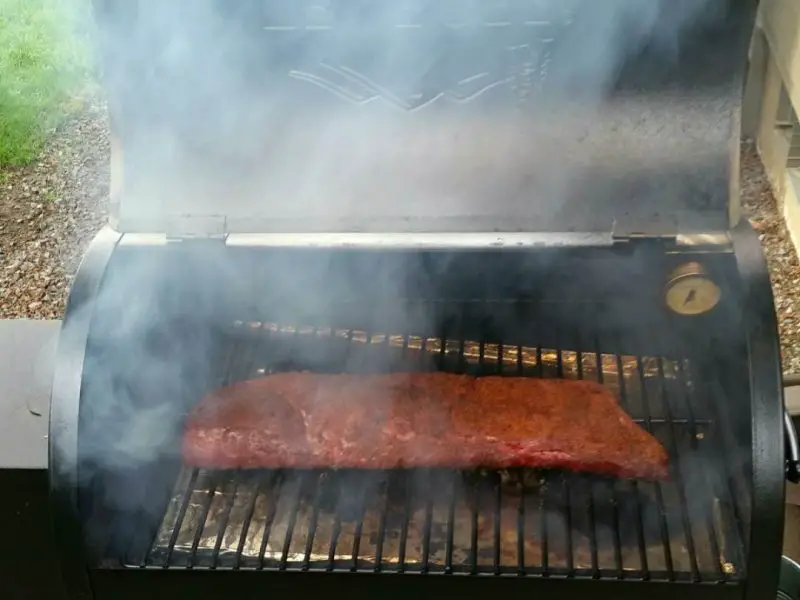
Pellet Smoker- For smoking ribs, a small-size pellet smoker like a Traeger 22 might be perfect, but a Traeger 34 will be more versatile. There are many different designs and models out there, so you’ll want to consider which one is right for you – it may depend on the type of meat you plan on smoking, the size of your backyard, the quality of construction, and other factors.
Click here to see our list of Top Pellet Smokers
Wood Pellets- With a pellet grill always use a stronger wood type than you would for any other type of smoker. Pellet grills tend to burn cleaner than electric smokers or stick burners so you can use varieties like mesquite or hickory without getting a bitter taste.
Many people have a favorite brand of pellets, and other people only use the pellets that are recommended by the pellet grill manufacturer, but I like to try different products for each food until I am happy with my results.
Having plenty of pellets for your smoker is also very important because if you run out your pellet smoker is done.
Thermometer- an instant-read thermometer is always the best for ribs. Knowing when your ribs are done is a matter of temperature and tenderness, so an accurate temperature reading is important. Probe thermometers are great at watching the temperature, but because ribs are thin it is hard to get an accurate reading.
Seasonings and Spices- When selecting seasonings and spices for smoked ribs in a pellet smoker, it is important to choose those that have a flavor profile that will pair well with the type of meat being cooked. For example, if you are cooking pork ribs then you may want to opt for something smoky or sweet like paprika, garlic powder, oregano, cumin, and brown sugar.
For beef ribs you may want to select a seasoning that has more of a bold flavor like garlic powder, black pepper, onion powder, and smoked paprika skipping the sweet items entirely.
Ribs- Our choice of ribs in a pellet smoker is St. Loius style pork ribs because it is symmetrically cut for even cooking, budget-friendly, and beginner-friendly.
A St Louis cut rib is a neat rectangle cut that is easy to deal with. Typically all you need to do is remove the silver skin, and you are ready to add rib rub seasoning. Now if regular pork rib racks are on sale you should buy those and trim them to your liking.
As for beef ribs, they are great, but because they have less fat content and are more expensive we like to skip those for convenience and beginners in general. We are going to address the difference in pork and beef ribs in the next section.
Pork ribs vs. Beef ribs
When comparing pork ribs to beef ribs, there are a few factors to consider. Pork ribs come in two varieties: baby back ribs and spare ribs, also known as St. Louis-style ribs when trimmed. These differ primarily in size, with spare ribs being much larger than their baby back counterparts.
Beef, on the other hand, is available in short and beef back varieties; the latter being more popular for smoking purposes. The composition of the meat also comes into play when talking about flavor; pork contains more fat than beef, giving it a richer flavor profile, but this isn’t to say that pork is always better than beef overall. Lastly, price-wise pork products tend to be cheaper than their bovine counterparts.
Pork ribs and beef ribs both make delicious barbeque, but it really boils down to a matter of preference. Many favor pork ribs because they are generally cheaper, have higher fat content, and are typically larger than their beef counterparts.
Meanwhile, many southerners will fight tooth and nail in the argument for beef ribs being the superior option for outdoor cooking. Ultimately, the smoking process is roughly the same for either variety, so it all comes down to an individual’s preferences and seasoning techniques in order to create a truly remarkable meal.
As for me, If you are a beginner start with St. Louis-style pork ribs. Once you can reproduce good results take a shot at beef back ribs.
Two tips for your first beef rib cook, foil wrap and foil wrap. After the rib rub seasoning has set up, wrap the beef ribs with a few tablespoons of unsalted butter. The result will be moist beef ribs, and the buttery taste will go well with the beef flavor profile.
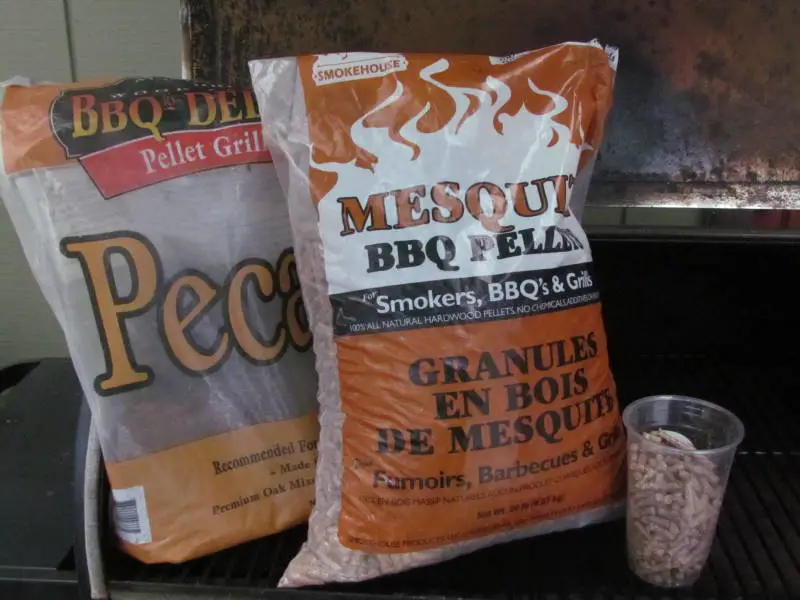
Type of Wood pellets to Choose
To make sure you get the right flavor, you’ll want to pay attention when it comes to choosing your wood pellets. Oak and maple are commonly used, but there’s a lot more to choose from that will add unique flavor profiles like mesquite, hickory, alder, pecan, or even fruit wood pellets like cherry, apple, and peach.
I always recommend going with a stronger wood than you might think in a pellet smoker because of its clean burning nature. Below are some notes that can guide you to a good choice, but try different combinations and settle on your favorite for the best-tasting ribs you can imagine.
Oak- this is the most versatile of all pellets, as it provides a mild flavor with a subtle smokiness. It’s also good for longer smokes and can be blended with other woods for an even better flavor profile. However, because it is so mild it is not our top pick for ribs, but we love it for salmon.
Mesquite- this pellet is the strongest in terms of flavor, so use sparingly for optimal results! I recommend this wood type for short smokes, home user blends, or starting smoke which is when you load an hour or more of this pellet and then add a mild pellet to finish your smoke.
Hickory- this classic choice is widely favored due to its bold flavor and smoky notes. Not too strong, not too mild – you can find just the right balance with this wood selection.
Alder- this type of wood is the most delicate of all and can easily be overwhelmed by stronger woods. For a light flavor and subtle smokiness, I recommend using this for slightly longer smokes or jerky where the meat could become bitter with strong wood types.
Pecan- this is a great choice for those who want to add a sweet, nutty flavor to their ribs. Pecan is milder than hickory but will still provide amazing flavor with just the right amount of smokiness. I have a saying that I live by, “When in doubt, get the pecan out.” Pecan might not be the top choice for every item, but it pairs well with everything from cheese to beef brisket.
Fruit (cherry, apple, peach)- these pellets are mild making them a top choice for long smokes or mild foods. The natural sweetness in the smoke fruit woods pairs well with pork, especially cherry. I like to use a mesquite and cherry pellet together by loading the pellet hopper with more than an hour of mesquite pellets then I add cherry pellets to finish the cook.
I would recommend starting with pecan wood pellets for a beginning rib cook, but there are so many combinations that you should not overlook. Another option for another day is manufacture’s blends AKA signature blends. My favorite is the Smokehouse products blend, but many people prefer the Traeger pellet blend, just food for thought!
Click here to see Smokehouse Products Wood Pellets Assortment on Amazon.com.
Rubs and Marinades
Seasoning your ribs with a dry rub or marinade is the key to adding flavor when smoking. Typically dry rub is more popular in the smoked meat world however don’t overlook the extra added flavor a marinade can bring to smoked meat.
A dry rub is a combination of dry spices that can be as simple as salt and pepper or twenty different seasonings. For a basic starter dry rub try our all-purpose 3211 mixture and add some brown sugar.
A marinade is a liquid that has the purpose of infusing food with flavor. This process can be a fast one hours soak or an eight hour rest overnight in the fridge. Typically, avoid medium times of four hours because liquid can be drawn out of your ribs and not have the chance to return before cooking.
My favorite way to use a marinade is the flavor it with a dry rub and then use the same dry rub before smoking to enhance the depth of flavor. Just wipe the marinade off the rib’s surface before applying and watch the salt levels.
Here are a couple of simple recipes to help you get started with the prep work.
Basic Beef Ribs Dry Rub
Ingredients
- ¼ cup brown sugar
- ¼ cup coarse ground black pepper
- 2 tbsp. Kosher salt
- 1 tbsp. Cumin
- 2 tbsp. Garlic powder
- 1 tbsp. Onion powder
- 1 tsp. Chili powder
- ½ tsp. Cayenne pepper
- 1 tsp. White pepper
Directions
mix the ingredients and coat the ribs generously for optimal flavor before smoking. For an even bolder experience, massage the seasonings into the rib rack then reapply to ensure maximum coverage and taste!
Basic Pork Ribs Dry Rub
Ingredients
- ½ cup brown sugar
- ¼ cup ground paprika
- 2 tbsp. Kosher salt
- 2 tbsp. Garlic powder
- 1 tbsp. Onion powder
- 1 tsp. Chili powder
- 1 tbsp. Black pepper
Directions
Start by combining all ingredients for a tantalizing dry rub. Generously cover each rack of ribs, rubbing in every ounce of flavor. Finish off with a second coat to make sure you’ve covered every area from edge to tip before firing up the smoker.
Many other combinations of seasonings perform well with pork ribs, follow this link to see our article on pork dry rubs.
Basic Marinade for Ribs
Ingredients
- ½ cup beef broth
- 4 tbsp. Extra virgin olive oil
- 2 tbsp. Worcestershire
- 1 tbsp. Soy sauce
- 1 tsp. Tabasco
- 2 tbsp. Apple cider vinegar
- 5 garlic cloves, minced
- A few sprigs of thyme
- ¼ cup dry rub seasoning
Directions
In a large bowl, combine the ingredients and mix well. Then place your rib rack in either a shallow container or zip baggie – whichever you prefer – then let it sit for at least 8 hours or overnight so that all of the flavors can sink in.
Finally when ready to smoke, take out “wipe clean any extra marinade” before adding a lite coat of dry rub right on both sides.
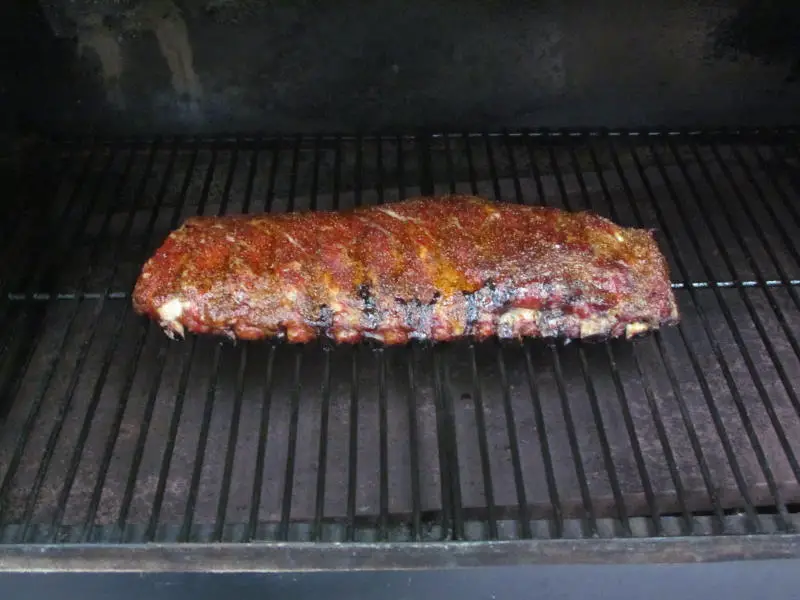
Smoking Ribs in a Pellet Smoker
Smoking ribs in a pellet smoker is much like traditional smoking but allows for better control over temperature and smoke levels. On shorter cooks like ribs, the smoke level is less of an issue.
Following the step-by-step process below will give you great results, make sure to avoid flare-ups and don’t run the pellet smoker out of fuel.
- Preheat your pellet smoker to 250°F. The best cooking temperature is 235°F, but some pellet smokers only adjust in 25-degree increments. In this case, the best temperature is 225°F with added cooking time.
- Prepare the rib rack by removing the silver skin, then trim excess fat and loose flaps of meat. Evenly apply the dry rub on the top and bottom of the rib rack, and try not to overdo the sides.
- Place the pork ribs in the smoker, arched side up, and maintain a consistent temperature.
- Pork ribs will take around 4 hours to smoke and become cooked fully, but it can all depend on the shape and weight of the ribs. So, after about 2 hours, flip your rib rack to even out the cooking. If you want to add BBQ sauce the 3 hour mark is a great time for a light coating.
- The best way to tell if the ribs are done is what is called the tug test. Pull on one of the bones in the middle of the rack, and if the bone releases with a small pull it is done. If the bone slides out with no resistance it could be overcooked. If you want to use a thermometer you can remove the ribs from the smoker when the temperature is above 155°F. The temperature should rise to 165°F after a 10-minute rest.
- Once you have removed them from the smoker, allow them to rest covered or in an unused oven for up to 20 minutes before cutting into them. Once cooled, separate them with a knife in between the bones and serve!
Alternative Method for Smoking Ribs
For the most succulent ribs you can sink your teeth into, look no further than ‘the 321 method‘ – a 3-step process that infuses flavor and tenderness to perfection! Wrap them in foil during Step 2 for maximum moistness.
The first step is a slow 3 hour smoke at a low temperature of 225°F or less. Step two is to tightly wrap the rib rack in foil with up to a cup of your favorite liquid for 2 hours. The third step is 1 hour to dry the surface and caramelize any finishing sauce by turning up the temperature to 275°F or higher.
Finishing Touches
Taking your ribs out of the pellet smoker is only the first part of an incredibly delicious barbeque experience. To finish them off, consider adding a finishing sauce made from a combination of bbq sauce and beef stock or equal parts liquid smoke, honey, and beef stock, but never overdo the liquid smoke.
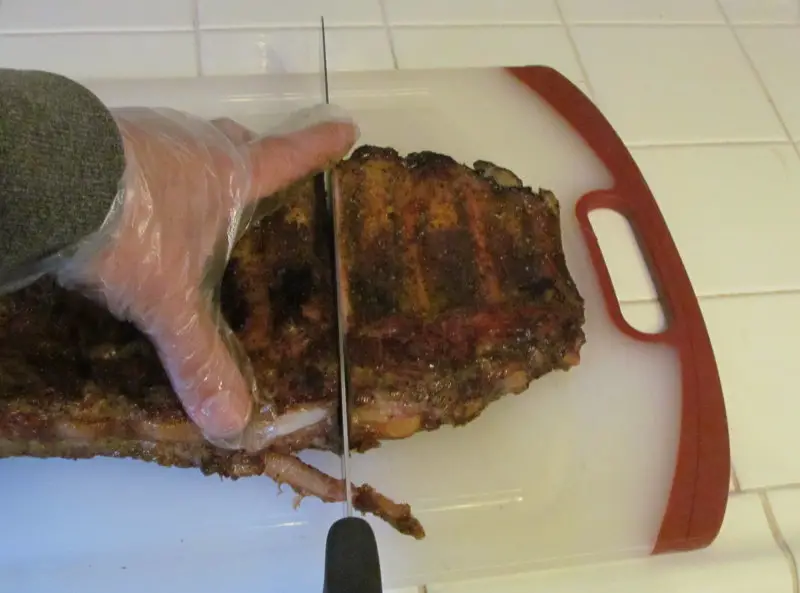
The last step of smoked ribs in a pellet smoker is often forgotten, but it can make all the difference. To make sure you get desired results, it is important to cut the ribs from the back side of the rack so that you can see where the bones are. The same Victorinox slicing knife that works well on a brisket can make perfect cuts on a rib rack. Set the ribs upside down on the cutting board and just cut evenly between the bones.
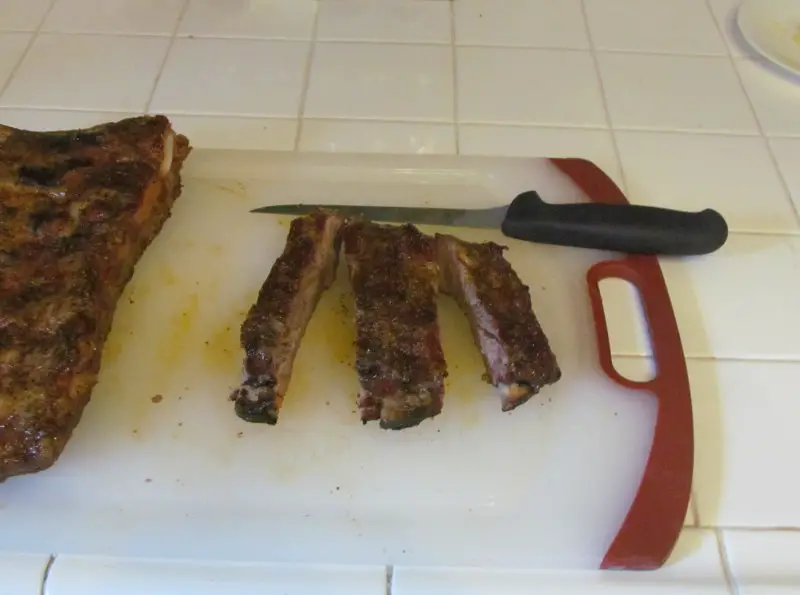
If the ribs are not big and meaty you might consider making a Hollywood cut by removing every other bone with a boning knife. A sharp boning knife will help you achieve clean cuts and an even finish.
Timing is also important to get the best results. The warm finishing glaze should be applied to the top and bottom immediately after removing the rib rack from the pellet smoker. After a minimum 10-minute rest you can cut your ribs however you prefer but serve immediately.
Tips and tricks for making ribs
- Consider grilling off your ribs. After your ribs are done, sauce them up with your favorite BBQ sauce, then sear them for a minute on each side to char the sauce.
- Mist with apple juice to avoid the ribs becoming dry. A generic food-grade spray bottle will work great for clear apple juice or other thin liquids.
- Many people like to use a butter spray, like Olivio Butter Spray. This is very commonly used in bbq competitions and can add a mild buttery taste to your ribs when used as a finishing sauce.
- Cut your rack upside down with a long meat-slicing knife for a clean uniform cut. The best part of flipping your rib rack over is being able to see the bones.
- Smoking your ribs low and slow will get better results for beginners. The main reason this works for beginners is that you can take your time and pull the ribs at the perfect time.
- Bigger rib racks are better. Larger racks of ribs normally have more meat between each bone for you to enjoy. The only down side to large racks of ribs is longer cooking times.
- Always trim the silver skin! Leaving the silver skin on the back of the rib rack will block smoke and seasonings from flavoring the meat. Removing the silver skin is not hard with a paper towel when the rib rack is cold. First, trim the fat and loose meat, then side a dull knife under the silver skin then use a paper towel to pull on the silver skin. Also, the chewy silver skin stuck in your teeth is just not good.
- If you want to add smokier flavor to your ribs, consider a pellet tray or pellet tube. Fill a pallet tray with the same pellets you are using to fuel your pellet smoker. Light the pellets, get it smoking well, and place it on the pellet grill rack close to the pellet hopper. The smoke should flow across the ribs as the pellets burn, adding a great smoke flavor.
Conclusion
Smoking ribs in a pellet smoker is a great way to cook and enjoy some delicious pork ribs. By following the simple instructions of preheating your pellet smoker, and evenly applying dry rubs as well as BBQ sauce, you can achieve delicious results.
You’ll also want to keep an eye on the temperature and watch it carefully so that it remains consistent throughout the smoking process. Keep in mind that pork ribs will take around four hours to be cooked thoroughly, and use the tug test or a finished temperature of 165°F after a 10-minute rest to know when they’re done.
So why not give it a try yourself? Now that you know how to smoke ribs in a pellet smoker, what are you waiting for? Do you have a pellet smoker? Smoke some pork ribs today!
